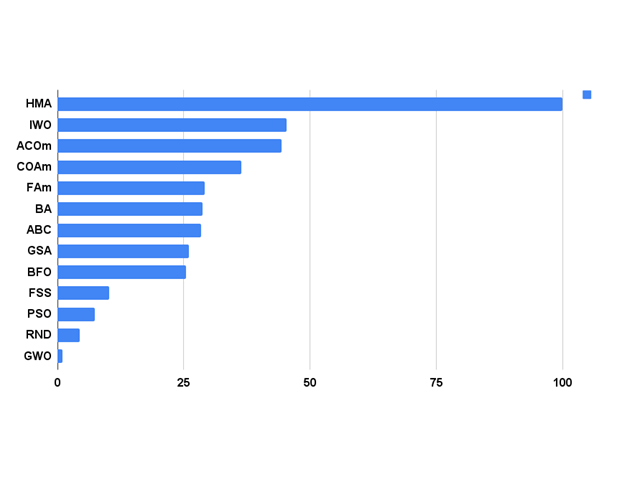Andrey Dik / 프로필
- 정보
|
11+ 년도
경험
|
4
제품
|
107
데몬 버전
|
|
15
작업
|
0
거래 신호
|
0
구독자
|
A group for communication on optimization and free product testing://t.me/+vazsAAcney4zYmZi
Attention! My Telegram doppelgangers have appeared, my real nickname is @JQS_aka_Joo
My github with optimization algorithms: https://github.com/JQSakaJoo/Population-optimization-algorithms-MQL5
All my publications: https://www.mql5.com/en/users/joo/publications
I have been developing systems based on machine learning technologies since 2007 and in the field of artificial
intelligence, optimization and forecasting.
I took an active part in the development of the MT5 platform, such as the introduction of support for universal parallel
computing on the GPU and CPU with OpenCL, testing and backtesting of distributed
computing in the LAN and cloud during optimization in MT5, my test functions are included in the standard delivery of the terminal.
⭐⭐ ⭐ ⭐ ⭐ ⭐ ⭐ ⭐ ⭐⭐ ⭐ ⭐ ⭐ ⭐ ⭐ ⭐ ⭐ ⭐ ⭐ ⭐ ⭐ ⭐ ⭐ ⭐ ⭐ ⭐ ⭐ ⭐ ⭐ ⭐ ⭐ ⭐ ⭐ ⭐ ⭐ ⭐
My Products:
https://www.mql5.com/en/users/joo/seller
Recommended Brokers:
https://rbfxdirect.com/ru/lk/?a=dnhp

The article considers a group of optimization algorithms known as Evolution Strategies (ES). They are among the very first population algorithms to use evolutionary principles for finding optimal solutions. We will implement changes to the conventional ES variants and revise the test function and test stand methodology for the algorithms.

The article examines the impact of changing the shape of probability distributions on the performance of optimization algorithms. We will conduct experiments using the Smart Cephalopod (SC) test algorithm to evaluate the efficiency of various probability distributions in the context of optimization problems.

The first part was devoted to the well-known and popular algorithm - simulated annealing. We have thoroughly considered its pros and cons. The second part of the article is devoted to the radical transformation of the algorithm, which turns it into a new optimization algorithm - Simulated Isotropic Annealing (SIA).

The Simulated Annealing algorithm is a metaheuristic inspired by the metal annealing process. In the article, we will conduct a thorough analysis of the algorithm and debunk a number of common beliefs and myths surrounding this widely known optimization method. The second part of the article will consider the custom Simulated Isotropic Annealing (SIA) algorithm.

The article presents a complete exploration of the Nelder-Mead method, explaining how the simplex (function parameter space) is modified and rearranged at each iteration to achieve an optimal solution, and describes how the method can be improved.

In this article, we will consider the algorithm that demonstrates the most controversial results of all those discussed previously - the differential evolution (DE) algorithm.

The article presents an optimization algorithm based on the patterns of constructing spiral trajectories in nature, such as mollusk shells - the spiral dynamics optimization (SDO) algorithm. I have thoroughly revised and modified the algorithm proposed by the authors. The article will consider the necessity of these changes.

The article considers an interesting algorithm derived from inanimate nature - intelligent water drops (IWD) simulating the process of river bed formation. The ideas of this algorithm made it possible to significantly improve the previous leader of the rating - SDS. As usual, the new leader (modified SDSm) can be found in the attachment.

In this article, we will consider another optimization algorithm inspired by inanimate nature - Charged System Search (CSS) algorithm. The purpose of this article is to present a new optimization algorithm based on the principles of physics and mechanics.
The article discusses Stochastic Diffusion Search (SDS), which is a very powerful and efficient optimization algorithm based on the principles of random walk. The algorithm allows finding optimal solutions in complex multidimensional spaces, while featuring a high speed of convergence and the ability to avoid local extrema.
The article considers the algorithm of the MEC family called the simple mind evolutionary computation algorithm (Simple MEC, SMEC). The algorithm is distinguished by the beauty of its idea and ease of implementation.
The article presents a detailed description of the shuffled frog-leaping (SFL) algorithm and its capabilities in solving optimization problems. The SFL algorithm is inspired by the behavior of frogs in their natural environment and offers a new approach to function optimization. The SFL algorithm is an efficient and flexible tool capable of processing a variety of data types and achieving optimal solutions.
The article describes the principles, methods and possibilities of using the Electromagnetic Algorithm in various optimization problems. The EM algorithm is an efficient optimization tool capable of working with large amounts of data and multidimensional functions.
Saplings Sowing and Growing up (SSG) algorithm is inspired by one of the most resilient organisms on the planet demonstrating outstanding capability for survival in a wide variety of conditions.
이 글에서는 원숭이 알고리즘(MA) 최적화 알고리즘에 대해 알아보겠습니다. 원숭이들이 어려운 장애물을 극복하고 가장 접근하기 어려운 나무 꼭대기에 도달하는 능력은 MA 알고리즘의 아이디어의 기초가 되었습니다.
이번 기사에서는 완벽한 하모니를 찾는 과정에서 영감을 얻은 가장 강력한 최적화 알고리즘인 하모닉 서치(HS)에 대해 알아보고 테스트해 보겠습니다. 현재 평가에서 선두를 달리고 있는 알고리즘은 무엇일까요?
GSA는 무생물에서 영감을 얻은 모집단 최적화 알고리즘입니다. 알고리즘에 구현된 뉴턴의 중력 법칙과 그리고 물리적 객체의 상호 작용을 모델링하는 높은 신뢰성 덕분에 우리로 하여금 행성계와 은하단의 매혹적인 춤을 관찰하게 해 줍니다. 이 기사에서는 가장 흥미롭고 독창적인 최적화 알고리즘 중 하나를 살펴볼 것입니다. 우주의 객체의 움직임에 대한 시뮬레이터도 있습니다.
The product has been updated to version 1.6 (including for MT5), in which the already incredible search capabilities have become even cooler! Owners of purchased licenses for AO Core can always be sure that they have the best solution search thanks to the author's constant research in the field of optimization. Follow my news and read my articles, I wish you all success in all your endeavors!

